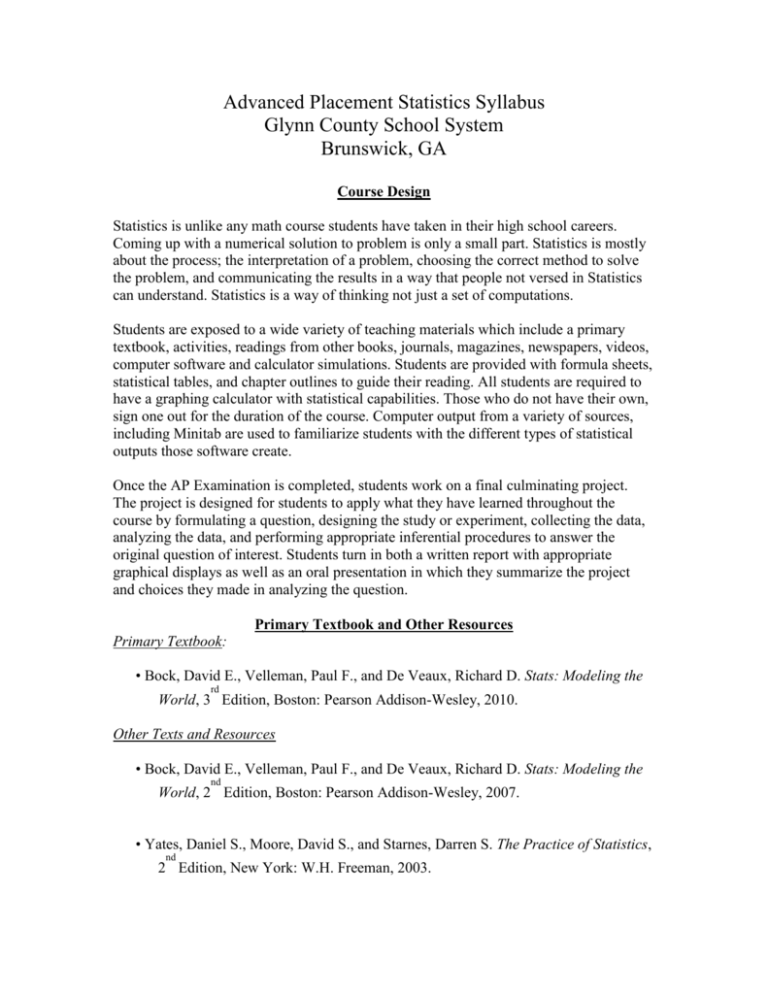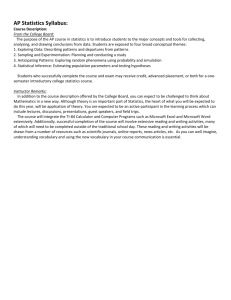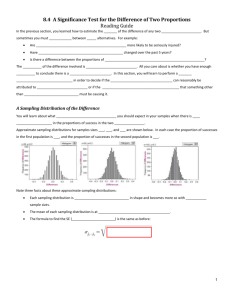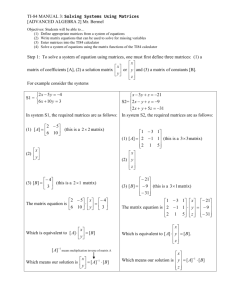
Advanced Placement Statistics Syllabus
Glynn County School System
Brunswick, GA
Course Design
Statistics is unlike any math course students have taken in their high school careers.
Coming up with a numerical solution to problem is only a small part. Statistics is mostly
about the process; the interpretation of a problem, choosing the correct method to solve
the problem, and communicating the results in a way that people not versed in Statistics
can understand. Statistics is a way of thinking not just a set of computations.
Students are exposed to a wide variety of teaching materials which include a primary
textbook, activities, readings from other books, journals, magazines, newspapers, videos,
computer software and calculator simulations. Students are provided with formula sheets,
statistical tables, and chapter outlines to guide their reading. All students are required to
have a graphing calculator with statistical capabilities. Those who do not have their own,
sign one out for the duration of the course. Computer output from a variety of sources,
including Minitab are used to familiarize students with the different types of statistical
outputs those software create.
Once the AP Examination is completed, students work on a final culminating project.
The project is designed for students to apply what they have learned throughout the
course by formulating a question, designing the study or experiment, collecting the data,
analyzing the data, and performing appropriate inferential procedures to answer the
original question of interest. Students turn in both a written report with appropriate
graphical displays as well as an oral presentation in which they summarize the project
and choices they made in analyzing the question.
Primary Textbook and Other Resources
Primary Textbook:
• Bock, David E., Velleman, Paul F., and De Veaux, Richard D. Stats: Modeling the
rd
World, 3 Edition, Boston: Pearson Addison-Wesley, 2010.
Other Texts and Resources
• Bock, David E., Velleman, Paul F., and De Veaux, Richard D. Stats: Modeling the
nd
World, 2 Edition, Boston: Pearson Addison-Wesley, 2007.
• Yates, Daniel S., Moore, David S., and Starnes, Darren S. The Practice of Statistics,
nd
2 Edition, New York: W.H. Freeman, 2003.
• Texas Instruments TI83+/TI84+ Graphing Calculators.
• Yates, Daniel S., Moore, David S., and Starnes, Darren S. Statistics Through
Applications, New York: W.H. Freeman, 2005.
• Scheaffer, Gnanadeskian, Watkins, Witmer. Activity-Based Statistics, New York:
Springer-Verlag, 1996
• College Board. AP Statistics Free Response Problems. New Jersey: College Board,
2006.
• Newspaper/Magazine/Internet articles to illustrate concepts currently being covered
in class.
Assessment
Warm-ups Students are assigned warm-ups upon entering the classroom each day.
Warm-ups are example AP exam multiple choice problems. Occasionally, warm-ups are
collected as a quiz grade.
Homework Students are assigned homework daily. Homework is collected and graded
the following day. Because we are on a block schedule, students are expected to plan for
one to two hours of work each night for this course. Homework is reviewed each day in
class and used as a class discussion tool.
Quizzes/Tests Due to the lack of time in a block setting, small quizzes/assessments are
administered frequently. A chapter quiz is given for each chapter in the textbook. A test
is given for each of the textbook’s units, which comprise of four to six chapters each. The
quizzes are specific to the topics covered, whereas the tests spiral all of the material
learned to date. The tests are structured similarly to the AP Examination with free
response and multiple choice questions.
Daily Methodology
The first day usually involves a discussion of the reading and notes from a Powerpoint
presentation. Over the next few days, there is a shift from teacher-lead lectures to smallgroup work and discussion, which is intended to tie the specifics to the larger concepts
and themes.
In most chapters, after the initial exposure to the material, there is an activity or
investigation.
Student understanding of concepts and applications are checked daily through problems
and teacher questioning.
Good statisticians need to be effective communicators. Good communication is a major goal
of the course. Students are expected to explain problems using proper vocabulary and to
express themselves clearly and efficiently. Finding the solution to a problem is not sufficient
either in school or in world beyond school; one must be able to explain why the solution is
correct, and that the process leading to that solution is logical and well thought out.
While not a requirement of the course, taking the AP exam is certainly an expectation of the
course. Students who participate in the class in the manner described above will be well
prepared to take the exam, and will be strongly encouraged to do so. Whether or not
a student plans to take the exam, he/she will be required to prepare for it.
Review for the AP Exam
The course is taught with the philosophy of AP Statistics as outlined in the Course
Description and Teacher’s Guide. To that end, prepping for the exam starts on the first
day of class. To help students prepare what is required in terms of statistical
communication and analytic writing, previous released free-response questions are
assigned at various intervals throughout the course. Students do not only compose their
own responses, but use the rubrics to grade each other’s work. This should help them
become familiar with the types of responses the AP readers are looking for when scoring
responses.
All of the topics are covered at least two weeks prior to the AP Exam test date. The time
leading up to the exam is spent writing free-response answers and multiple choice
questions. If there is enough time, students are given a timed practice exam.
Throughout the course, prior material is spiraled into homework problems and test
problems. When released free-responses are assigned, some are from much earlier
material so that the students are constantly exposed to earlier learned material.
Course Projects
The course projects are in the form of extended writing assignments or oral presentations.
These are formal, therefore, form and technical adequacy are
• Students write up a summary of a magazine or newpaper article that involves a
statistical study. They are asked to identify the key components of the study (who,
what, where, why, how, etc.) and look for examples of misrepresentations or poor
reasoning. More stock is put into their writing as they have just scratched the
surface of the course material.
• Nielsen Data Project. Students input the Nielsen ratings from the current week of
television shows. They create appropriate charts, graphs, and summary statistics.
They then write a paper comparing the viewership of the different television
networks. Students then create a five minute presentation to an advertising
executive to tell what stations, shows, times, or days of week bring in the most
viewers.
• Students are to design a taste test. They are expected to incorporate all stages of the
design process from design (randomization, blindness, etc.) to data collection to a
descriptive report of the results.
Course Content and Outline
The following outline describes this course’s content by book chapter and unit. Since we
are in a 90 minute block schedule meeting 5 days a week for one semester, our timeframe
must be aggressive.
Unit I – Exploring and Understanding Data (7 days)
Chapter 1: Statistics Starts Here
• Activity: Read an article that references some statistics or statistical study.
Chapter 2: Data
• Types of data
• Create Data Lists in the TI84+
• Activity: In-class survey analysis
Chapter 3: Displaying and Describing Categorical Data
• Frequency Tables
• Pie Charts
• Bar Charts
• Contingency Tables
Chapter 4: Displaying Quantitative Data
• Histograms
• Stem plots
• Dot plots
• Shape, Center, and Spread
• Time plots
• Cumulative Frequency Graphs
• Re-expressing Skewed Data
• Using the TI84+
• Activity: Weighing Pennies
Chapter 5: Describing Distributions Numerically
• Describing Spread: Range, Interquartile Range, Standard Deviation
• Boxplots
• Outliers
• Using the TI84+
• Project: Nielsen Ratings (Described above)
Chapter 6: The Standard Deviation as a Ruler and the Normal Model
• Standardized Scores
• The 68-95-99.7 Rule
• Percentiles and quartiles
• Normal Probability Plots
• Using TI84+
Unit I - Test
Unit II – Exploring Relationships Between Variables (8 days)
Chapter 7: Scatterplots, Association, and Correlation
• Making and Describing Scatterplots
• The Correlation Coefficient
• Properties of the Correlation Coefficient
• Straightening Scatterplots
• Using the TI84+
Chapter 8: Linear Regression
• The Linear Model
• Residuals
• Least Squares Regression Line
• Regression to the Mean
• Coefficient of Determination
• Using the TI84+
Chapter 9: Regression Wisdom
• Looking for Groups in Data
• Extrapolating
• Lurking Variables and Causation
• Activity: BVD Wandering Point Worksheet (from Instructors Resource Guide)
Chapter 10: Re-Expressing Data: Get It Straight!
• Straightening Relationships
• Goals of Re-expression
• The Ladder of Powers
• Using the TI84+
Unit II Test
Unit III – Gathering Data (6 days)
Chapter 11: Understanding Randomness
• Random Behavior
• Simulations
• Estimating Likelihood of Outcomes Using Simulations
• Using the TI84+ for Simulations
• Activity: The Spread of an Epidemic, Part I (From YMS, the Practice of Statistics)
Chapter 12: Sample Surveys
• Bias in Sampling
• Simple Random Samples
• Stratified Random Samples
• Cluster/Multistage Sampling
Chapter 13: Experiments and Observational Studies
• Observational Studies
• Completely Randomized Design
• Designing Experiments
• Control Groups
• Treatments
• Blocking
• Replication
• Blinding
• Confounding and Lurking Variables
• Project: Taste Test
Unit III Test
Unit IV – Randomness and Probability (12 days)
Chapter 14: From Randomness to Probability
• Definition of probability, outcomes, and events
• Law of Large Numbers
• Properties of Probabilities
• Independence
• Disjoint Events
Chapter 15: Probability Rules
• The Addition Rule
• The Multiplication Rule
• Tree Diagrams
• Reversing the Conditions
• Activity: Casino Lab
Chapter 16: Random Variables
• Properties of Discrete Random Variables
• Expected Value of a Discrete Random Variable
• Linear Functions and Linear Combinations of Discrete Random Variables
• Properties of Continuous Random Variables
• Using the TI84+
• Activity: Game: Greed
• Project: Oral Presentation Required
Midterm Exam – AP Exam Format – 25 Multiple Choice and 5 Open-Ends
Chapter 17: Probability Models
• The Geometric Model
• The Binomial Model
• Using the Normal Model to Approximate the Binomial Model
• Using the TI84+ Distribution Menu
Unit IV Test
Unit V – From the Data Hand to the World at Large (14 days)
Chapter 18: Sampling Distribution Models
• Sampling Distributions
• Sampling Distribution Model for Proportions
• Sampling Distribution Model for Means
• The Central Limit Theorem
• Standard Error
• Activity: Spinning Pennies
Chapter 19: Confidence Intervals for Proportions
• Properties of Point Estimates
• Logic of a Confidence Interval
• Meaning of Confidence Level
• Confidence Intervals for Population Proportions
• Checking Assumptions and Conditions
• Using the TI84+
• Activity: Flipping Coin Simulation to Investigate affects of Sample Size and
Confidence Level
Chapter 20: Testing Hypotheses About Proportions
• Forming Hypotheses
• Logic of Hypothesis Testing
• Type I and Type II Errors
• One and Two-Sided Hypothesis Tests for Population Proportions
• Test Statistics and p-values
• Checking Conditions
• Using the TI84+
Chapter 21: More About Tests
• Interpreting p-values
• Significance Level
• Relationship between Confidence Intervals and Hypothesis Tests
• Power
• Effect Size
Chapter 22: Comparing Two Proportions
• Two-sided Hypothesis Test for Population Proportions
• Pooling
• Checking Conditions
• Using the TI84+
Unit V Test
Unit VI – Learning About the World (10 days)
Chapter 23: Inferences About Means
• The t-Distribution
• Degrees of Freedom
• Assumptions and Conditions
• Finding t-values and probabilities
Chapter 24: Comparing Means
• Hypothesis Test for the difference of two means (unpaired)
• Two-sided Tests
• Confidence Interval for the difference of two means (unpaired)
• Activity: Comparing SAT Verbal and Math Scores
Chapter 25: Paired Samples and Blocks
• Matched Pairs Hypothesis Test
• Matched Pairs Confidence Interval
• Using the TI-84+
• Choosing the correct test
• Activity: Group Project from BVD Teacher Resource Guide
Unit VI Test
Unit VI – Learning About the World (10 days)
Chapter 26: Comparing Counts
• The Chi-Square Distribution
• Goodness of Fit test
• Checking conditions
• Assessing normality
• Homogeneity of Proportions Test
• Test of independence
• Choosing the correct test
• Using the TI-84+
• Activity: M&M’s
Chapter 27: Inferences for Regression
• Hypothesis Test for the slope of a least squares regression line
• Confidence interval for the slope of a least squares regression line
• Using computer output
• Using the TI-84+
• Activity: Models, Models, Models
Unit VII Test
Review for the AP Exam
• 2002 Complete Exam (under actual testing conditions)
• All free-response questions that were not completed during the year
• Multiple choice questions from various review books
Post AP Exam
• Cumulative Review Project (complete process from design to data collection to
analysis to presentation)
• Student created lessons for Regression








